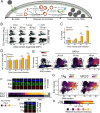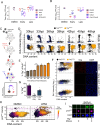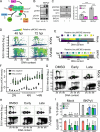Single-cell analysis reveals host S phase drives large T antigen expression during BK polyomavirus infection
- PMID: 39636788
- PMCID: PMC11620372
- DOI: 10.1371/journal.ppat.1012663
Single-cell analysis reveals host S phase drives large T antigen expression during BK polyomavirus infection
Abstract
BK polyomavirus (BKPyV) is a major cause of kidney transplant failure, for which there are no antivirals. The current model is that BKPyV expresses TAg (large T antigen) early during infection, promoting cells to enter S phase where the viral DNA can access the host replication machinery. Here, we performed a single-cell analysis of viral TAg expression throughout the cell cycle to reveal that robust TAg expression required replication of the host DNA first. By using inhibitors that only affect host and not viral replication, we show that both TAg expression and viral production rely on an initial S phase. BKPyV is known to promote cellular re-replication, where the cell re-enters S phase from G2 phase (without passing through mitosis or G1 phase) to prolong S phase for viral replication. Thus, BKPyV infection results in cells with greater than 4N DNA content. We found that these subsequent rounds of replication of the host DNA relied on canonical host cell cycle machinery and regulators despite BKPyV infection. Together, these findings suggest a model for polyomavirus replication, where robust viral TAg expression depends on an initial host S phase and that BKPyV primarily replicates during host re-replication. Having a better understanding of the molecular events that are required for BKPyV production will help identify effective therapeutic targets against BKPyV.
Copyright: © 2024 Needham et al. This is an open access article distributed under the terms of the Creative Commons Attribution License, which permits unrestricted use, distribution, and reproduction in any medium, provided the original author and source are credited.
Conflict of interest statement
The authors have declared that no competing interests exist.
Figures






Similar articles
-
BK Polyomavirus Activates the DNA Damage Response To Prolong S Phase.J Virol. 2019 Jun 28;93(14):e00130-19. doi: 10.1128/JVI.00130-19. Print 2019 Jul 15. J Virol. 2019. PMID: 31043526 Free PMC article.
-
Regulation of Virus Replication by BK Polyomavirus Small T Antigen.J Virol. 2023 Mar 30;97(3):e0007723. doi: 10.1128/jvi.00077-23. Epub 2023 Mar 14. J Virol. 2023. PMID: 36916919 Free PMC article.
-
Roles of ATM and ATR-mediated DNA damage responses during lytic BK polyomavirus infection.PLoS Pathog. 2012;8(8):e1002898. doi: 10.1371/journal.ppat.1002898. Epub 2012 Aug 30. PLoS Pathog. 2012. PMID: 22952448 Free PMC article.
-
The effect of BK polyomavirus large T antigen on CD4 and CD8 T cells in kidney transplant recipients.Transpl Immunol. 2022 Oct;74:101655. doi: 10.1016/j.trim.2022.101655. Epub 2022 Jun 28. Transpl Immunol. 2022. PMID: 35777612 Review.
-
Diagnostics, treatment, and immune response in BK polyomavirus infection after pediatric kidney transplantation.Pediatr Nephrol. 2020 Mar;35(3):375-382. doi: 10.1007/s00467-018-4164-3. Epub 2018 Dec 11. Pediatr Nephrol. 2020. PMID: 30539254 Review.
Cited by
-
Ribosomal protein S25 promotes cell cycle entry for a productive BK polyomavirus infection.Philos Trans R Soc Lond B Biol Sci. 2025 Mar 6;380(1921):20230390. doi: 10.1098/rstb.2023.0390. Epub 2025 Mar 6. Philos Trans R Soc Lond B Biol Sci. 2025. PMID: 40045781
References
MeSH terms
Substances
Grants and funding
LinkOut - more resources
Full Text Sources

